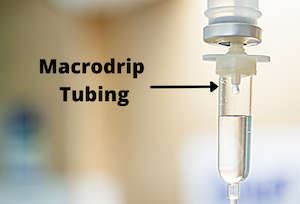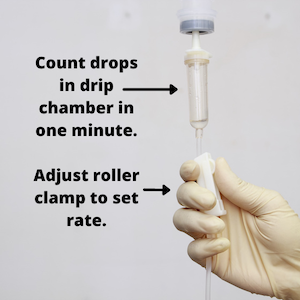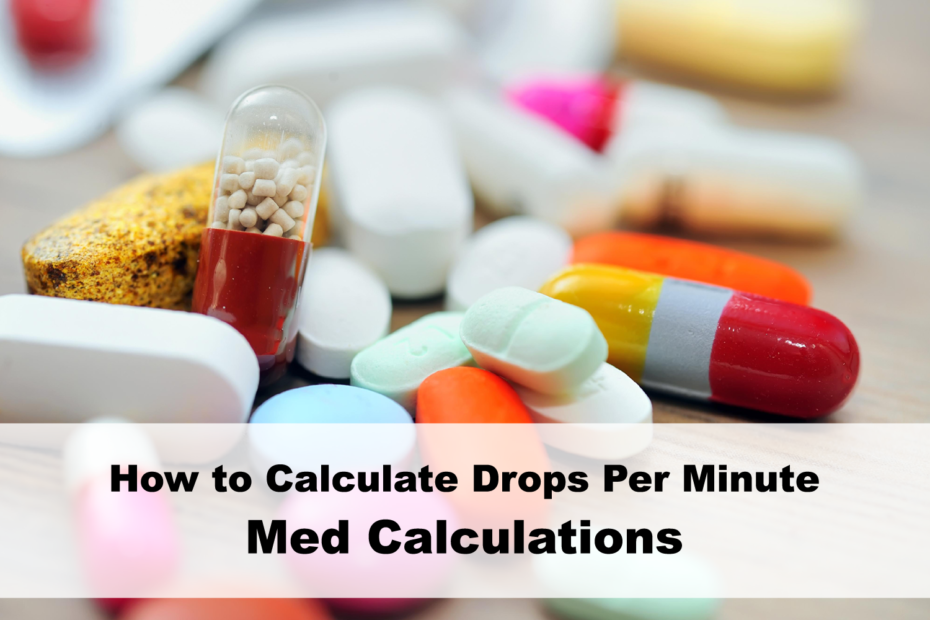Welcome back to our med calculation series and our blog post. In this installment we will review how to calculate IV drip flow rates in drops per minute (gtts/min) when delivering free flowing gravity infusions. While continuous IV infusions are typically delivered via infusion pumps, there may be times when an electronic pump is not available. This requires calculating the number of drops per minute (gtts/min).
Before we begin the calculations, it is important to note that there are two types of IV tubing that will deliver fluid at a specific flow rate, known as the drip factor: macrodrip and microdrip. The drip factor, which can be found printed on the IV tubing package, is the number of drops (gtts) in one mililiter (mL) of solution delivered by gravity. The rate is measured by counting the number of drops that fall into the drip chamber each minute.
Lets have a look on Drip factor: Macrodrip and Microdrip
Drip factor: Macrodrip and Microdrip
Macrodrip tubing
Macrodrip tubing is wider, producing larger drops and is available in three sizes: 10, 15, or 20 drops per mL (gtt/mL). This tubing is typically used to infuse fluids at a rapid rate.


Microdrip tubing
Microdrip tubing is narrower, producing smaller drops with a drip factor of 60 gtts/mL. It is often used to infuse fluids to pediatric and neonatal patients or medications requiring a precise flow rate.
Based on the drip factor, you can adjust the rate of the infusion by tightening or loosening the roller clamp and by counting the drops in the drip chamber each minute. For example, for macrodrip tubing with a drip factor of 20 gtt/mL, 20 drops is equivalent one mL. If you set the rate at 20 drops per minute, one mL is infusing per minute, or 60 mL per hour. If you double the rate to 40 drops per minute, you increase the rate to 120 mL per hour.

Your institution may utilize electronic flow control devices that calculate the number of drops per minute however, it’s important to confirm that these devices are working properly. You should double check the rate each shift.
As a general rule of thumb, if the infusion rate is high, 100 mL/hour or more, you will want to use macrodrip tubing. Blood products are often infused using macrodrip tubing (15 gtt/mL). If the infusion rate is slower or requires more precision, you should use microdrip tubing.
Calculation Shortcut
You can use Dimensional Analysis (DA) to calculate the drip rate (gtts/min) but there are some shortcuts you can take. Let’s set up the equation using the DA method first. Then we’ll simplify it so you can see how we get to the shortcut.
1. We want to know drops per minute (gtts/min). Place that on the left side of the equation.  2. Next we add the drip factor for the tubing set we are using. Then alternate the labels until they cancel out. Add the infusion rate (mL/hour), followed by the time (1 hour over 60 minutes).
2. Next we add the drip factor for the tubing set we are using. Then alternate the labels until they cancel out. Add the infusion rate (mL/hour), followed by the time (1 hour over 60 minutes). Cancel the labels.
Cancel the labels..png.aspx)
What you are left with are drops (gtts) multiplied by the infusion rate divided by 60.
 You can rearrange the equation and divide the drops (gtts) by 60 and multiply by infusion rate.
You can rearrange the equation and divide the drops (gtts) by 60 and multiply by infusion rate.

Since all the drip factors are easily divisible into 60, you can simply divide the infusion rate by the following factors.


 To simplify, take the infusion rate and divide by the following based on the size of the tubing set.
To simplify, take the infusion rate and divide by the following based on the size of the tubing set.
Macrodrip
- 10 gtt/mL – divide the infusion rate by 6
- 15 gtt/mL – divide the infusion rate by 4
- 20 gtt/mL – divide the infusion rate by 3
Microdrip
- 60 gtt/mL divided by 60 is 1. Therefore, the drip rate is the same as the flow rate (drip rate = flow rate).
Let’s practice!
Example 1: How to Calculate IV Flow Rate in gtts/min
Administer 1 liter of lactated ringer’s solution IV over 10 hours. There are no electronic infusion pumps available and the only IV tubing set in stock has a drip factor of 20 drops/mL. How many drops per minute (gtts/min) will you run the infusion?
Using the shortcut method:
Step 1: Convert liters to mL. Step 2: Determine the hourly rate of the infusion. Take total volume (1000 mL) and divide by time (10 hours).
Step 2: Determine the hourly rate of the infusion. Take total volume (1000 mL) and divide by time (10 hours). Step 3: Divide the hourly infusion rate by the drip factor. Our tubing drip factor is 20 gtts/mL so we divide the hourly rate by 3.
Step 3: Divide the hourly infusion rate by the drip factor. Our tubing drip factor is 20 gtts/mL so we divide the hourly rate by 3. Answer = 33 gtt/min
Answer = 33 gtt/min
Example 2: How to Calculate IV Flow Rate in gtts/min
Administer 1 unit of whole blood (500 mL) over 2 hours. You select IV tubing with a drip factor of 15 drops/mL. How many drops per minute (gtt/min) will you run the infusion?
Using the shortcut method:
Step 1: Convert liters to mL.
The whole blood is already converted to mililiters: 500 mL. Step 2: Determine the hourly rate of the infusion. Take total volume (500 mL) and divide by time (2 hours).
Step 2: Determine the hourly rate of the infusion. Take total volume (500 mL) and divide by time (2 hours). Step 3: Divide the hourly infusion rate by the drip factor. Our tubing drip factor is 15 gtts/mL so we drivide the hourly rate by 4.
Step 3: Divide the hourly infusion rate by the drip factor. Our tubing drip factor is 15 gtts/mL so we drivide the hourly rate by 4. Answer = 63 gtt/min
Answer = 63 gtt/min
Example 3: How to Calculate IV Flow Rate in gtts/min
You arrive for your shift and while you wait to get report you check your patient’s infusions. A one liter bag of normal saline is hanging by gravity without an electronic infusion pump. The tubing is labeled with a drip factor of 10 gtts/mL. You count the drops in the chamber for one minute and find it is running at 45 gtts/min. You check the orders and find that one liter of NS should be infusing over 6 hours. Is the infusion running at the correct rate?
Step 1: Convert liters to mL. Step 2: Determine the hourly rate of the infusion. Take total volume (1000 mL) and divide by time (6 hours).
Step 2: Determine the hourly rate of the infusion. Take total volume (1000 mL) and divide by time (6 hours). Step 3: Divide the hourly infusion rate by the drop factor. Our tubing drop factor is 10 gtts/mL so we drivide the hourly rate by 6.
Step 3: Divide the hourly infusion rate by the drop factor. Our tubing drop factor is 10 gtts/mL so we drivide the hourly rate by 6.
Answer = 28 gtt/min
The infusion is not running at the correct rate. You will need to slow down the infusion so that is it running at 28 drops per minute.
Click Here for Infusion rate (drops/minute) Calculator
General Tips:
- Confirm tubing set drip rate on package (i.e., 10, 15, 20, 60 gtt/mL).
- Always count the drops for a full minute for best accuracy.
- Check that your answer makes sense clinically.
- Double check your work.
- Have a colleague check your work.
I hope you found this shortcut helpful. If you’re not comfortable using the shortcut, you can always fall back on the dimensional analysis method. Finally, many institutions will have a gravity flow rate drip chart available for reference so that you do not have to calculate the drops per minute (see the example below). Best of luck and keep on practicing!
| Gravity Flow Rate Drip Chart | ||||
| Flow Rate (mL/hr) | 10 gtt/mL (drops/min) | 15 gtt/mL (gtts/min) | 20 gtts/mL (drops/min) | 60 gtts/mL (drops/min) |
| 10 | 2 | 2 | 3 | 10 |
| 25 | 4 | 6 | 8 | 25 |
| 50 | 8 | 12 | 17 | 50 |
| 75 | 12 | 19 | 25 | 75 |
| 100 | 17 | 25 | 33 | 100 |
| 125 | 21 | 31 | 42 | 135 |
| 150 | 25 | 37 | 50 | 150 |
| 200 | 33 | 50 | 67 | 200 |
| 250 | 42 | 62 | 83 | 250 |
| 500 | 83 | 125 | 167 | 500 |
| 1,000 | 167 | 250 | 333 | 1,000 |
References:
Cookson, K.L. (2013). Dimensional analysis: Calculate dosages the easy way. Nursing2013, 43(6), 57-62.
How fast should the drops drip?. Nursing Made Incredibly Easy!, 2(4), 60-62.
Koharchik, L.S. & Hardy, E.C. (2013). As easy as 1, 2, 3! Dosage calculations. Nursing Made Incredibly Easy!, 11(1), 25 – 29.
Wilson, K.M. (2013). The nurse’s quick guide to I.V. drug calculations. Nursing Made Incredibly Easy!, 11(2), 1 – 2.
